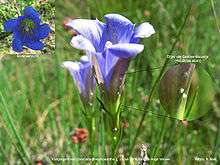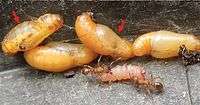Phengaris alcon
| Alcon blue | |
|---|---|
.jpg) | |
| Scientific classification | |
| Kingdom: | Animalia |
| Phylum: | Arthropoda |
| Class: | Insecta |
| Order: | Lepidoptera |
| Family: | Lycaenidae |
| Genus: | Phengaris |
| Species: | P. alcon |
| Binomial name | |
| Phengaris alcon | |
| Synonyms | |
|
Glaucopsyche alcon | |
Phengaris alcon, the Alcon blue or Alcon large blue, is a butterfly of the Lycaenidae family and is found in Europe and northern Asia.
Taxonomy
There are five subspecies:
- P. a. alcon (Central Europe)
- P. a. jeniseiensis (Shjeljuzhko, 1928) (southern Siberia)
- P. a. sevastos Rebel & Zerny, 1931 (Carpathians)
- P. a. xerophila Berger, 1946 (Central Europe)
- †P. a. arenaria (Netherlands)
There has been controversy over whether Phengaris rebeli, currently regarded as an ecotype within the Alcons, should be listed as a separate species. The two types are morphologically indistinguishable and molecular analysis has revealed little genetic difference, mostly attributable to localized habitat adaptation.[2][3][4] Still some maintain that they should be treated as distinct species, especially for conservation purposes, because they parasitise different host ant colonies and parasitise these ants at different rates,[5] and also rely on different host plant species (Gentiana pneumonanthe in the case of Phengaris alcon and Gentiana cruciata in the case of Phengaris rebeli).[6]
Ecology

The species can be seen flying in mid- to late summer. It lays its eggs onto the marsh gentian (Gentiana pneumonanthe); in the region of the Alps they are sometimes also found on the related willow gentian (Gentiana asclepiadea).[7] The caterpillars eat no other plants.
Parasitic relationship

Like some other species of Lycaenidae, the larval (caterpillar) stage of P. alcon depends on support by certain ants; it is therefore known as a myrmecophile.
Alcon larvae leave the food plant when they have grown sufficiently (4th instar) and wait on the ground below to be discovered by ants. The larvae emit surface chemicals (allomones) that closely match those of ant larvae, causing the ants to carry the Alcon larvae into their nests and place them in their brood chambers. Once adopted into a nest, Alcon larvae are fed the regurgitations of nurse ants (just as other ant brood), a process called trophallaxis.[8] This parasitic method is known as the "cuckoo" strategy and is an alternative to the predatory strategy employed by most other members of the genus such as Phengaris arion.[9] Though less common, the cuckoo strategy has been found to have several advantages over the predatory strategy. For one, it is more trophically efficient than preying directly on other ant grubs, and as a result, significantly more cuckoo-type larvae can be supported per nest than predatory larvae.[10] Another advantage of cuckoo feeding is that individuals, having pursued a higher degree of social integration, have a higher chance of surviving when a nest is overcrowded or facing food shortage because ants preferentially feed the larvae; compared to the type of scramble competition that can devastate predatory larvae, this contest competition results in much lower mortality.[11][12] Though the cuckoo strategy has its advantages, it also comes with important costs; with greater host ant specialization comes much more limited ecological niches.[13]
When the Alcon larva is fully developed it pupates. Once the adult hatches it must run the gauntlet of escaping. The ants recognise the butterfly to be an intruder, but when they go to attack it with their jaws they can't grab anything substantial as the newly emerged adult butterfly is thickly clothed in loosely attached scales.[14]
Over time, some ant colonies that are parasitized in this manner will slightly change their larva chemicals as a defence, leading to an evolutionary "arms race" between the two species.[15][16]
Generally, Lycaenidae species which have a myrmecophilous relationship with the ant genus Myrmica are locked to primary host specificity. The Alcon blue is unusual in this regard in that it uses different host species in different locations throughout Europe, and often uses multiple host species even within the same location and population.[17][18][19] Though it may be adopted into the nests of multiple Myrmica species within a given site, there is typically one "primary" species with which the locally adapted larvae can best socially integrate, leading to drastically higher survival rates.[20] Across Europe, Alcons are known to use Myrmica scabrinodis, Myrmica ruginodis, Myrmica rubra, Myrmica sabuleti, Myrmica scabrinodis, Myrmica schencki, and rarely Myrmica lonae, and Myrmica specioides.[21][22]
Predation
P. alcon larvae are sought underground by the Ichneumon eumerus wasp. On detecting a P. alcon larva the wasp enters the nest and sprays a pheromone that causes the ants to attack each other. In the resulting confusion the wasp locates the butterfly larva and injects it with its eggs. On pupation, the wasp eggs hatch and consume the chrysalis from the inside.[23]
See also
- Orachrysops niobe Brenton blue butterfly from South Africa, with a similar lifecycle
References
- ↑ Gimenez Dixon (1996). "Maculinea alcon". IUCN Red List of Threatened Species. Version 2006. International Union for Conservation of Nature. Retrieved 8 May 2006.
- ↑ Als, Thomas D.; Vila, Roger; Kandul, Nikolai P.; Nash, David R.; Yen, Shen-Horn; Hsu, Yu-Feng; Mignault, André A.; Boomsma, Jacobus J.; Pierce, Naomi E. "The evolution of alternative parasitic life histories in large blue butterflies". Nature. 432 (7015): 386–390. doi:10.1038/nature03020.
- ↑ Fric, Zdenĕk; Wahlberg, Niklas; Pech, Pavel; Zrzavý, Jan (2007-07-01). "Phylogeny and classification of the Phengaris–Maculinea clade (Lepidoptera: Lycaenidae): total evidence and phylogenetic species concepts". Systematic Entomology. 32 (3): 558–567. doi:10.1111/j.1365-3113.2007.00387.x. ISSN 1365-3113.
- ↑ Ugelvig, L. V.; Vila, R.; Pierce, N. E.; Nash, D. R. (2011-10-01). "A phylogenetic revision of the Glaucopsyche section (Lepidoptera: Lycaenidae), with special focus on the Phengaris–Maculinea clade". Molecular Phylogenetics and Evolution. 61 (1): 237–243. doi:10.1016/j.ympev.2011.05.016.
- ↑ Tartally, A; Nash, D. R.; Lengyel, S.; Varga, Z (2008). "Patterns of host ant use by sympatric populations of Maculinea alcon and M.'rebeli'in the Carpathian Basin". Insectes Sociaux. 55 (4): 370–381. doi:10.1007/s00040-008-1015-4. Retrieved 19 October 2013.
- ↑ Thomas, J. A.; Elmes, G. W.; Wardlaw, J. C.; Woyciechowski, M. "Host specificity among Maculinea butterflies in Myrmica ant nests". Oecologia. 79 (4): 452–457. doi:10.1007/BF00378660. ISSN 0029-8549.
- ↑ Bellmann, Heiko (2003). Der neue Kosmos-Schmetterlingsführer. ISBN 3-440-09330-1.(German)
- ↑ Thomas, J. A.; Elmes, G. W. (1998-11-01). "Higher productivity at the cost of increased host-specificity when Maculinea butterfly larvae exploit ant colonies through trophallaxis rather than by predation". Ecological Entomology. 23 (4): 457–464. doi:10.1046/j.1365-2311.1998.00153.x. ISSN 1365-2311.
- ↑ Thomas, J.A.; J.C. Wardlaw (1990). "The effect of queen ants on the survival of Maculinea arion larvae in Myrmica ant nests". Oecologia. 85: 87–91. doi:10.1007/bf00317347.
- ↑ Thomas, J. A.; Elmes, G. W. (1998-11-01). "Higher productivity at the cost of increased host-specificity when Maculinea butterfly larvae exploit ant colonies through trophallaxis rather than by predation". Ecological Entomology. 23 (4): 457–464. doi:10.1046/j.1365-2311.1998.00153.x. ISSN 1365-2311.
- ↑ Thomas, J. A.; Wardlaw, J. C. "The capacity of a Myrmica ant nest to support a predacious species of Maculinea butterfly". Oecologia. 91 (1): 101–109. doi:10.1007/BF00317247. ISSN 0029-8549.
- ↑ Elmes, G. W.; Thomas, J. A.; Wardlaw, J. C.; Hochberg, M. E.; Clarke, R. T.; Simcox, D. J. "The ecology of Myrmica ants in relation to the conservation of Maculinea butterflies". Journal of Insect Conservation. 2 (1): 67–78. doi:10.1023/A:1009696823965. ISSN 1366-638X.
- ↑ Elmes, G. W.; Thomas, J. A.; Wardlaw, J. C.; Hochberg, M. E.; Clarke, R. T.; Simcox, D. J. "The ecology of Myrmica ants in relation to the conservation of Maculinea butterflies". Journal of Insect Conservation. 2 (1): 67–78. doi:10.1023/A:1009696823965. ISSN 1366-638X.
- ↑ Piper, Ross (2007). Extraordinary Animals: An Encyclopedia of Curious and Unusual Animals. Greenwood Press.
- ↑ Nash, David R.; Als, Thomas D.; Maile, Roland; Jones, Graeme R.; Boomsma, Jacobus J. (2008-01-04). "A Mosaic of Chemical Coevolution in a Large Blue Butterfly". Science. 319 (5859): 88–90. doi:10.1126/science.1149180. ISSN 0036-8075. PMID 18174441.
- ↑ "The battle of the butterflies and the ants". Nature News. 3. 2008.
- ↑ Akino, T.; Knapp, J. J.; Thomas, J. A.; Elmes, G. W. (1999-07-22). "Chemical mimicry and host specificity in the butterfly Maculinea rebeli, a social parasite of Myrmica ant colonies". Proceedings of the Royal Society of London B: Biological Sciences. 266 (1427): 1419–1426. doi:10.1098/rspb.1999.0796. ISSN 0962-8452. PMC 1690087
 .
. - ↑ Elmes, G.; Akino, T.; Thomas, J.; Clarke, R.; Knapp, J. "Interspecific differences in cuticular hydrocarbon profiles of Myrmica ants are sufficiently consistent to explain host specificity by Maculinea (large blue) butterflies". Oecologia. 130 (4): 525–535. doi:10.1007/s00442-001-0857-5. ISSN 0029-8549.
- ↑ Schönrogge, K.; Wardlaw, J. C.; Peters, A. J.; Everett, S.; Thomas, J. A.; Elmes, G. W. "Changes in Chemical Signature and Host Specificity from Larval Retrieval to Full Social Integration in the Myrmecophilous Butterfly Maculinea rebeli". Journal of Chemical Ecology. 30 (1): 91–107. doi:10.1023/B:JOEC.0000013184.18176.a9. ISSN 0098-0331.
- ↑ Thomas, J. A.; Elmes, G. W. (1998-11-01). "Higher productivity at the cost of increased host-specificity when Maculinea butterfly larvae exploit ant colonies through trophallaxis rather than by predation". Ecological Entomology. 23 (4): 457–464. doi:10.1046/j.1365-2311.1998.00153.x. ISSN 1365-2311.
- ↑ Steiner, Florian M.; Sielezniew, Marcin; Schlick-Steiner, Birgit C.; Höttinger, Helmut; Stankiewicz, Anna; Górnicki, Adam. "Host specificity revisited: New data on Myrmica host ants of the lycaenid butterfly Maculinea rebeli". Journal of Insect Conservation. 7 (1): 1–6. doi:10.1023/A:1024763305517. ISSN 1366-638X.
- ↑ Tartally, A.; Nash, D. R.; Lengyel, S.; Varga, Z. (2008-06-28). "Patterns of host ant use by sympatric populations of Maculinea alcon and M. 'rebeli' in the Carpathian Basin". Insectes Sociaux. 55 (4): 370–381. doi:10.1007/s00040-008-1015-4. ISSN 0020-1812.
- ↑ "Butterfly and Wasp: A Devious, Deceitful Cycle of Life". Wired.com.
External links
| Wikimedia Commons has media related to Maculinea alcon. |
- David Nash pages on Maculinea alcon
- Pictures of eggs and caterpillar
- Pictures of adults
- Smell-wars between butterflies and ants
